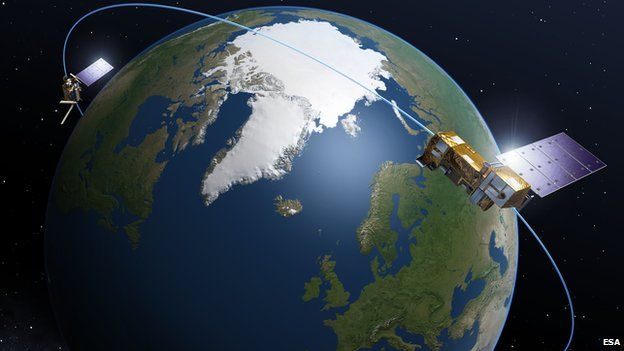Airbus to build critical European weather satellites
- Published

The competition to build Europe's next generation of polar-orbiting weather satellites has been won by Airbus.
The big aerospace concern was declared the winner at the latest meeting of the European Space Agency's (Esa) Industrial Policy Committee (IPC).
A contract valued in the hundreds of millions of euros will be signed by Esa and Airbus in due course.
The existing Metop series, as it is known, has a profound impact on the quality of weather forecasting.
The satellites' sensors gather profiles of atmospheric conditions, layer by layer.
Studies comparing all the different types of meteorological observations (including surface weather stations, balloons and aeroplanes, etc) have found Metop data to have the biggest single contribution to the accuracy of the 24-hour look ahead, at around 25%.
The improved forecasts of storms and other extreme events are estimated to be worth billions of euros annually in terms of lives saved and property damage avoided.
Thursday's IPC decision is therefore a critically important one for the continent, by ensuring there is continuity of data when the existing series of Metop satellites is retired.
"Metop first generation has established itself as an essential series of satellites for weather forecasting. It gives the most detailed measurements from space for such purposes," explained Esa programme manager Graeme Mason.
"The first objective of the second generation (SG) is simply to continue the observations without a gap because we cannot do without them. But we want also to improve the measurements - to improve the resolution, to see finer details in the atmosphere.
"And the third objective is to make additional measurements, and we'll be flying a couple of new instruments," he told BBC News.
Metop-SG will carry 11 instruments spread across two platforms. This is a major difference from the first generation series which packs all the sensors on to a single satellite. Two of these spacecraft have so far been launched; a third will go up at the end of the decade.
Another major difference between the two series will be the approach to end-of-life decommissioning.
The first series will be de-orbited by nudging them down from their roughly 800km-high operational altitude until they are caught by the atmosphere, and pulled in to burn to destruction. This should take no more than 25 years, to comply with international space-debris guidelines.
The disposal of the second generation, however, will be faster and more controlled.
The satellites will fly with bigger fuel tanks and more powerful thrusters, enabling them to target their destructive dive on to an uninhabited region of the South Pacific.
The whole procedure should take just a month.
Esa says the accumulation of old hardware in orbit is becoming a significant issue and the plans for Metop-SG demonstrate the seriousness with which it is tackling the problem.
The competitors for the SG contract were given an additional two months to work out how best to carry out the de-orbiting. It will mean two thirds of the fuel on each spacecraft being reserved just for the end-of-life manoeuvres.
The first pair of Metop-SG satellites should launch in 2021/22. The third and final pair will likely go up in the 2030s, ensuring continuity of data deep into the 2040s.
Airbus will use its facilities in Germany, France and the UK for most of the work on Metop-SG.
Jonathan.Amos-INTERNET@bbc.co.uk and follow me on Twitter: @BBCAmos
- Published16 July 2013
- Published25 April 2013
- Published17 September 2012
- Published22 April 2013
- Published21 November 2012
- Published18 September 2012
- Published6 July 2012
- Published16 November 2011
- Published22 June 2010
- Published28 October 2011